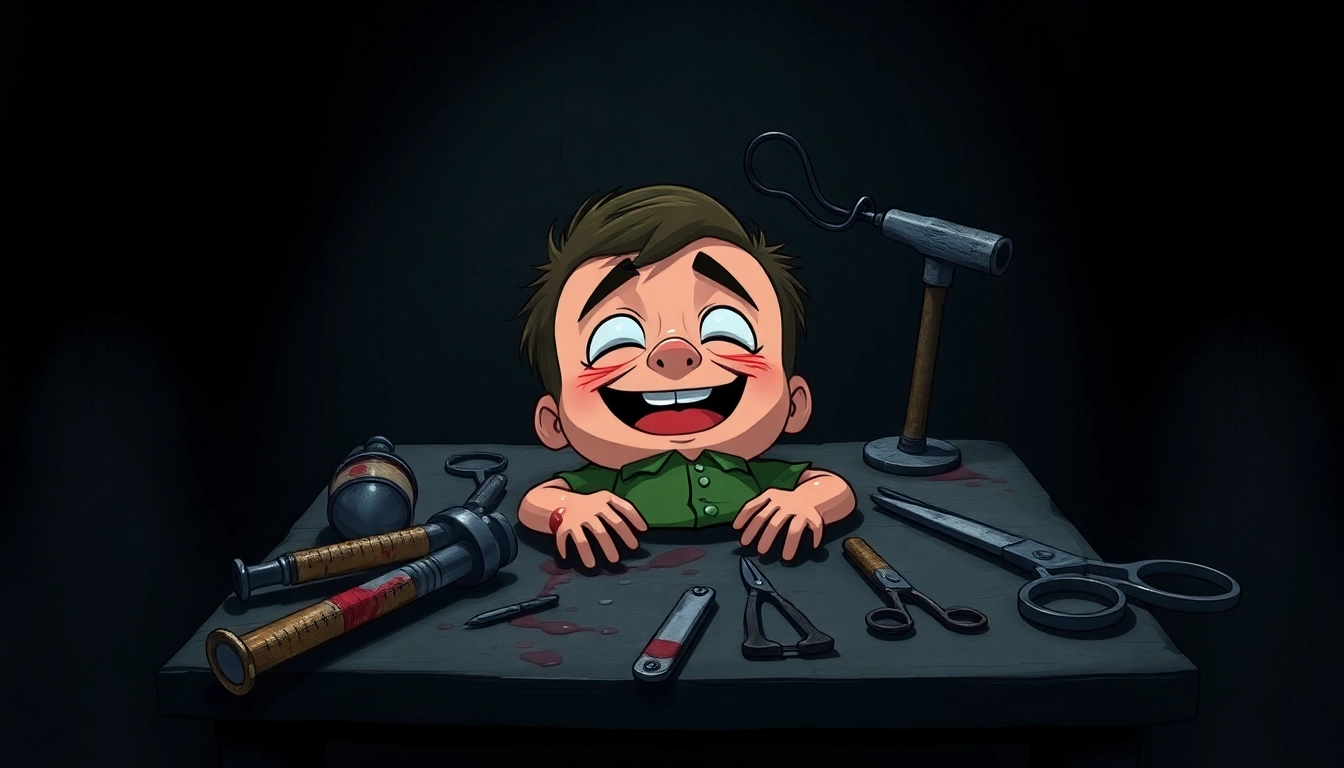Overview and Context: The Psychological Horror of BloodMoney
In the realm of psychological horror and morally challenging games, blood money has carved out a disturbing niche that tests the boundaries of human morality. Unlike traditional horror titles that rely on monsters or jump scares, BloodMoney plunges players into an unsettling journey where each click not only earns money but also chips away at moral integrity. This dark clicker game masterfully blends minimalist mechanics with a profound narrative, forcing players to confront their own ethical limits amidst a backdrop of desperation and suffering.
Set against the backdrop of a personal crisis—a serious medical diagnosis demanding $25,000 for treatment—BloodMoney transforms a simple act of clicking into a moral dilemma. The game introduces Harvey, a cheerful and seemingly innocent character whose suffering escalates with each interaction. As players navigate this twisted landscape, they are faced with choices that reveal the duality of human nature: the instinct to survive versus the moral cost of that survival. This article explores the intricate mechanics, narrative depth, and psychological themes that make BloodMoney a standout in the dark clicker genre.
BloodMoney Game Mechanics and Narrative Overview
Core Gameplay and Clicking Mechanics
At its heart, BloodMoney is a clicker game—simple in design but complex in implication. Players are tasked with clicking on Harvey, a bright and cheerful character, to generate income necessary for their urgent medical bills. Each click adds a fixed amount of money to the player’s total, with the initial goal of reaching $25,000. The mechanics are straightforward: more clicks mean more money, but each action comes with a cost—Harvey’s increasing pain and suffering.
This simple mechanic belies a deeper psychological tension. The more you click, the more Harvey endures, visually and emotionally. The game subtly tracks your progress, and as your earnings increase, so does Harvey’s visible distress. The game’s design ensures that every click is loaded with moral weight—are you doing what’s necessary, or what’s right?
The Dark Narrative of Harvey and the Player
Harvey appears as a cheerful, naive character who is unaware of the darker implications of the shop’s offerings. His surprise at more violent tools suggests he doesn’t understand what he is being forced to endure, adding a tragic layer to the narrative. As players purchase upgrades—ranging from needles to hammers—the visual and emotional toll on Harvey intensifies, creating a haunting atmosphere that underscores the game’s core themes of exploitation and moral decay.
The story unfolds through subtle visual cues, dialogue, and Harvey’s reactions, which evolve from innocent amusement to genuine fear and suffering. This progression forces players to reflect on their choices—do they prioritize efficiency or compassion? The narrative is deliberately minimalist, emphasizing the psychological horror of seemingly mundane actions that carry profound moral consequences.
The Dark Narrative of BloodMoney Game and Harvey
Harvey: The Innocent Facade
Harvey functions as both a character and a mirror of the player’s conscience. His cheerful demeanor creates a stark contrast to the increasing violence of the shop’s tools, highlighting the dissonance between appearance and reality. The game hints that Harvey might be unaware of the true nature of the upgrades—his surprise at violent weapons suggests innocence, which makes the moral implications even more disturbing.
The Player’s Moral Descent
As players delve deeper into the game, they are confronted with choices that impact Harvey’s suffering and their own moral standing. The temptation to maximize profits leads to purchasing more violent tools, pushing players toward a darker path. This descent reflects the broader theme of human nature: how desperation can erode morality and compel individuals to act against their conscience.
Visual and Psychological Horror
The game’s visual design plays a crucial role in amplifying the horror. As Harvey’s suffering increases, his appearance and reactions become more distressed—eyes widen, facial expressions distort, and body language conveys pain. These subtle cues evoke empathy or guilt in players, making the moral stakes visceral and real. The psychological horror is heightened by the game’s ability to make players question whether their efficiency is worth Harvey’s torment.
Featured Gameplay Videos and Player Reactions
Many players have shared their experiences through gameplay videos, revealing diverse approaches and moral standpoints. Some opt for minimal harm, purchasing only the necessary upgrades to reach their goal, while others succumb to the darker temptations of violent tools to maximize profits quickly. These videos often highlight the emotional impact of Harvey’s reactions, with players expressing feelings of guilt, empathy, or detachment.
Commentary from the community emphasizes how the game’s design cleverly manipulates player psychology. The visual cues, Harvey’s changing expressions, and the escalating violence orchestrate a compelling narrative of moral compromise. Watching different playthroughs reveals that despite the simplicity of mechanics, the game’s emotional depth varies significantly based on individual choices.
Upgrading System and Its Disturbing Consequences
The Shop: From Harmless to Horrific
The shop is where the real moral tension begins. Initially, players can purchase simple upgrades—perhaps a pillow or a harmless tool—that slightly increase earnings without causing much suffering. However, as the game progresses, the options become darker and more violent: needles, scissors, hammers, and even more grotesque implements. Each upgrade dramatically boosts profits but at a steep moral cost.
Visual and Psychological Impact of Upgrades
Every purchase alters Harvey’s appearance and emotional state. For example, buying a needle might cause Harvey to flinch or grimace, while a hammer might lead to a visible wound or an anguished scream. The game’s art style uses subtle changes to evoke strong emotional responses—creating a visceral experience that questions whether the pursuit of survival is worth such suffering.
Risk-Reward Dynamics and Player Agency
The upgrade system is designed to create a risk-reward dynamic: do you choose the safest, least harmful options, or do you push for maximum efficiency regardless of Harvey’s pain? The more violent the tool, the faster your earnings escalate. This tension is central to the game’s moral challenge—each decision pulls you closer to one of its multiple endings.
Multiple Pathways and Endings Based on Player Choices
The Three Endings: Good, Normal, and Bad
BloodMoney’s narrative culminates in three distinct endings, each reflecting the moral choices made throughout gameplay:
- The Good Ending: Achieved by minimizing Harvey’s suffering and purchasing only necessary upgrades. This path emphasizes compassion and moral integrity, even if it takes longer to reach the financial goal.
- The Normal Ending: A balanced approach, where players use moderate violence—perhaps employing scissors or similar tools—to reach their goal. This ending reflects compromise, sacrificing some morality for efficiency.
- The Bad Ending: The most disturbing route, where players maximize profits regardless of Harvey’s pain, purchasing violent tools like hammers or knives, leading to Harvey’s complete torment and a morally bankrupt conclusion.
How Player Choices Shape Outcomes
The game subtly tracks player behavior, not just through the tools purchased but also through visual and emotional cues. Harvey’s reactions, dialogue, and appearance serve as indicators of moral alignment. Interestingly, some players have discovered that even with violent tools, it’s possible to unlock the Good Ending by consciously choosing to minimize suffering in other ways, adding layers of complexity to the decision-making process.
Community Insights and Hidden Depths
Player Reflections and Moral Questions
The BloodMoney community is deeply engaged with the game’s moral implications. Many players report feeling genuine guilt or empathy after certain choices, demonstrating the game’s emotional potency. Discussions often revolve around the nature of morality—whether survival justifies cruelty, and what it reveals about human nature.
Hidden Details and Subtle Cues
Players have noted subtle hints suggesting Harvey might not understand the full extent of what’s happening. For instance, his surprise at violent tools implies innocence and ignorance, which intensifies the moral dilemma—are we exploiting someone who doesn’t comprehend the pain inflicted? These details deepen the narrative complexity and invite multiple interpretations.
Multiple Playthroughs and Discovering Hidden Content
Repeated playthroughs reveal that the game’s tracking system is more nuanced than initially perceived. Certain choices influence the ending subtly, and some players have managed to unlock alternate routes or hidden content by experimenting with different strategies. This encourages replayability and reflection on one’s moral stance.
The Broader Themes: Morality, Human Nature, and Desperation
Exploring Human Duality
BloodMoney masterfully captures the duality of human nature—the conflict between compassion and selfishness. Harvey symbolizes innocence, trying to aid the player, while the shop represents darker forces that manipulate and corrupt. The game questions whether morality is absolute or situational, especially under extreme circumstances.
Desperation as a Catalyst
The core narrative revolves around desperation—life-saving medical bills that seem insurmountable, forcing players into morally compromising decisions. This setting reflects real-world dilemmas faced by individuals in crisis, making the game’s themes profoundly relatable and unsettling.
Morality as a Spectrum
Rather than presenting morality in black and white, BloodMoney explores it as a spectrum. Players’ choices, whether minimal harm or maximum profit, lead to different endings, each with its own moral narrative. This nuanced approach challenges players to reflect on their own values and the cost of survival.
Why BloodMoney Stands Out in Horror and Clicker Games
Unlike many horror or clicker titles, BloodMoney combines minimalist gameplay with intense psychological depth. Its focus on moral dilemmas, emotional engagement, and visual storytelling creates a haunting experience that lingers long after the game ends. The subtlety of its design—using simple visuals, dialogue, and reactions—makes it a powerful tool for exploring human morality under duress.
Furthermore, its community-driven analysis and multiple endings foster ongoing discussion, elevating it beyond mere entertainment into a thought-provoking exploration of ethics and human nature.
Conclusion: Confronting Our Own Moral Boundaries
BloodMoney challenges us to ask difficult questions: How far are we willing to go to survive? Is efficiency worth the moral cost? The game’s unsettling premise and emotional depth make it a compelling mirror to our own values. It demonstrates that even in a dark, fictional universe, the choices we make reveal much about who we are and what we believe.
As you navigate the twisted world of blood money, remember that every click, upgrade, and decision reflects a facet of human morality. The game’s power lies in its ability to make us question our instincts and confront uncomfortable truths—reminding us that morality is often a complex, nuanced spectrum rather than a simple dichotomy.
Ultimately, BloodMoney isn’t just a game—it’s a profound psychological experiment that tests the limits of human empathy and survival. Are you ready to face your own moral boundaries? The choice is yours, but be warned: once you enter its dark world, there’s no going back.
For those intrigued by this intense exploration of morality and survival, dive deeper into the world of bloodmoney and discover how far you’re willing to go when your life is on the line.

